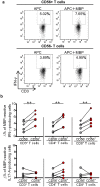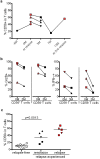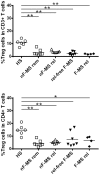Altered T cell phenotypes associated with clinical relapse of multiple sclerosis patients receiving fingolimod therapy
- PMID: 27752051
- PMCID: PMC5082790
- DOI: 10.1038/srep35314
Altered T cell phenotypes associated with clinical relapse of multiple sclerosis patients receiving fingolimod therapy
Abstract
Multiple sclerosis (MS) is a T cell-mediated autoimmune disease. Fingolimod, a highly effective disease-modifying drug for MS, retains CCR7+ central memory T cells in which autoaggressive T cells putatively exist, in secondary lymphoid organs, although relapse may still occur in some patients. Here, we analyzed the T cell phenotypes of fingolimod-treated, fingolimod-untreated patients, and healthy subjects. The frequency of CD56+ T cells and granzyme B-, perforin-, and Fas ligand-positive T cells significantly increased during fingolimod treatment. Each T cell subpopulation further increased during relapse. Interestingly, T cells from fingolimod-treated patients exhibited interferon-γ biased production, and more myelin basic protein-reactive cells was noted in CD56+ than in CD56- T cells. It is likely that the altered T cell phenotypes play a role in MS relapse in fingolimod-treated patients. Further clinical studies are necessary to investigate whether altered T cell phenotypes are a biomarker for relapse under fingolimod therapy.
Figures








Similar articles
-
Fingolimod does not impair T-cell release from the thymus and beneficially affects Treg function in patients with multiple sclerosis.Mult Scler. 2015 Oct;21(12):1521-32. doi: 10.1177/1352458514564589. Epub 2015 Jan 12. Mult Scler. 2015. PMID: 25583847
-
Peripheral blood T cell dynamics predict relapse in multiple sclerosis patients on fingolimod.PLoS One. 2015 Apr 28;10(4):e0124923. doi: 10.1371/journal.pone.0124923. eCollection 2014. PLoS One. 2015. PMID: 25919001 Free PMC article.
-
Five-year results from a phase 2 study of oral fingolimod in relapsing multiple sclerosis.Mult Scler. 2014 Jun;20(7):877-81. doi: 10.1177/1352458513513059. Epub 2013 Nov 30. Mult Scler. 2014. PMID: 24293455 Clinical Trial.
-
Oral fingolimod for the treatment of patients with relapsing forms of multiple sclerosis.Int J Clin Pract. 2011 Aug;65(8):887-95. doi: 10.1111/j.1742-1241.2011.02721.x. Epub 2011 Jun 16. Int J Clin Pract. 2011. PMID: 21679286 Review.
-
The Direct Effects of Fingolimod in the Central Nervous System: Implications for Relapsing Multiple Sclerosis.CNS Drugs. 2016 Feb;30(2):135-47. doi: 10.1007/s40263-015-0297-0. CNS Drugs. 2016. PMID: 26715391 Free PMC article. Review.
Cited by
-
NF-κB/mTOR/MYC Axis Drives PRMT5 Protein Induction After T Cell Activation via Transcriptional and Non-transcriptional Mechanisms.Front Immunol. 2019 Mar 19;10:524. doi: 10.3389/fimmu.2019.00524. eCollection 2019. Front Immunol. 2019. PMID: 30941147 Free PMC article.
-
Regulation of lymphocyte trafficking in central nervous system autoimmunity.Curr Opin Immunol. 2018 Dec;55:38-43. doi: 10.1016/j.coi.2018.09.008. Epub 2018 Sep 27. Curr Opin Immunol. 2018. PMID: 30268837 Free PMC article. Review.
-
Dysregulated lipid metabolism networks modulate T-cell function in people with relapsing-remitting multiple sclerosis.Clin Exp Immunol. 2024 Jul 12;217(2):204-218. doi: 10.1093/cei/uxae032. Clin Exp Immunol. 2024. PMID: 38625017 Free PMC article.
-
Tetracyclines Diminish In Vitro IFN-γ and IL-17-Producing Adaptive and Innate Immune Cells in Multiple Sclerosis.Front Immunol. 2021 Nov 26;12:739186. doi: 10.3389/fimmu.2021.739186. eCollection 2021. Front Immunol. 2021. PMID: 34899697 Free PMC article.
-
MicroRNA‑155 modulation of CD8+ T‑cell activity personalizes response to disease‑modifying therapies of patients with relapsing‑remitting multiple sclerosis.Med Int (Lond). 2023 Mar 20;3(2):20. doi: 10.3892/mi.2023.80. eCollection 2023 Mar-Apr. Med Int (Lond). 2023. PMID: 37032715 Free PMC article.
References
-
- Sospedra M. & Martin R. Immunology of multiple sclerosis. Annual review of immunology 23, 683–747 (2005). - PubMed
-
- Sallusto F. et al.. T-cell trafficking in the central nervous system. Immunological reviews 248, 216–227 (2012). - PubMed
-
- Steinman L. Immunology of relapse and remission in multiple sclerosis. Annual review of immunology 32, 257–281 (2014). - PubMed
-
- Brinkmann V. et al.. Fingolimod (FTY720): discovery and development of an oral drug to treat multiple sclerosis. Nature reviews. Drug discovery 9, 883–897 (2010). - PubMed
MeSH terms
Substances
LinkOut - more resources
Full Text Sources
Other Literature Sources
Research Materials
Miscellaneous

